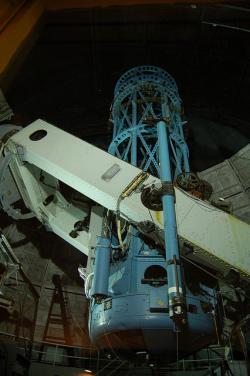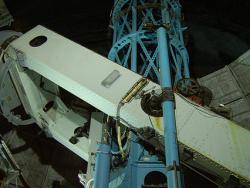When Halley’s comet returns to our quarter of the universe this year, the great 200-inch Hale Telescope, perched high on Palomar Mountain in California, will follow it across the sky. In fact, the 200-inch, the world’s largest telescope for a full three decades after its dedication in 1948, was the first telescope to detect the comet during its current return, back in 1982. We can always expect the phenomenal from the 200-inch.
Hale, George Ellery
YearAdded:
Image Credit:
Image Caption:
Era_date_from:

The increased light-grasp of this telescope made possible many notable advances in structural cosmology between 1924 and 1930, which have revised our ideas about the universe. One of these advances was that spiral nebulae are galactic units like our own; another was the idea of an expanding universe. George Ellery Hale began planning this project in 1906; Francis G. Pease was the chief designer and mechanical engineer. The telescope's mirror support and the use of mercury flotation to reduce the friction are among its outstanding mechanical engineering features.
YearAdded:
Image Credit:
Courtesy Flickr/Bruce Irving (CC BY 2.0)
Image Caption:
Mount Wilson Observatory, 100-inch Hooker Telescope
Era_date_from:
1918
1981
By:
Summer 1985 | Volume 1, Issue 1
When Halley’s comet returns to our quarter of the universe this year, the great 200-inch Hale Telescope, perched high on Palomar Mountain in California, will follow it across the sky. In fact, the 200-inch, the world’s largest telescope for a full three decades after its dedication in 1948, was the…
Innovations

The increased light-grasp of this telescope made possible many notable advances in structural cosmology between 1924 and 1930, which have revised our ideas about the universe. One of these advances was that spiral nebulae are galactic units like our own; another was the idea of an expanding… Read More


